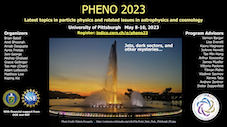Conveners
DM III
- Gopolang Mohlabeng (University of California, Irvine)
Ultralight axions and dark photons are compelling candidates for dark matter. In this talk, I will provide an overview of my recent work (arXiv:2207.05767, 2301.03622) on detecting radio-frequency axions and dark photons using radio telescopes. The detectability relies on two distinct underlying mechanisms. One mechanism involves local dark photon dark matter inducing harmonic oscillations of...
The minimum testable dark matter (DM) mass for almost all DM signatures in celestial bodies is determined by the rate at which DM evaporates. DM evaporation has previously been calculated assuming a competition between the gravitational potential of the object, and thermal kicks from the celestial-body matter. I will point out a new effect, where mediators with a range larger than the...
Dark photons can oscillate into SM photons via kinetic mixing in a way that is analogous to neutrino oscillations. Much like the MSW effect for neutrinos in environments of varying density, the probability for dark photons to convert to photons depends on the properties of the ambient background (density, electromagnetic fields, etc.) Resonances are even possible when there is a level-crossing...
Upcoming neutrino experiments are expected to detect the Diffuse Supernova Neutrino Background (DSNB). This requires pondering all possible sources of background. Sub-GeV dark matter (DM) which annihilates into neutrinos is a potential background that has not been considered so far. We simulate DSNB and DM signals, as well as backgrounds in the Hyper-Kamiokande detector. We find that...
The constituents of dark matter are still unknown, and the viable possibilities span a very large mass range. Specific scenarios for the origin of dark matter sharpen the focus to within about an MeV to 100 TeV. Most of the stable constituents of known matter have masses in the lower range, and a thermal origin for dark matter works in a simple and predictive manner in this mass range as well....
Stellar binaries have historically provided a rich target in the search for exotic compact objects such as primordial black holes (PBHs) or MACHOs. A sufficiently heavy compact object flying sufficiently close to a binary will disrupt or soften it, an effect that will show up in binary data as sparseness at large separation bins. While most studies have focused on the softening of wide...
